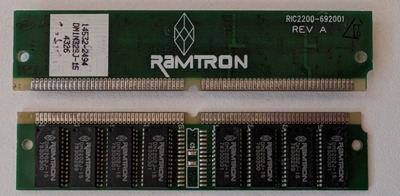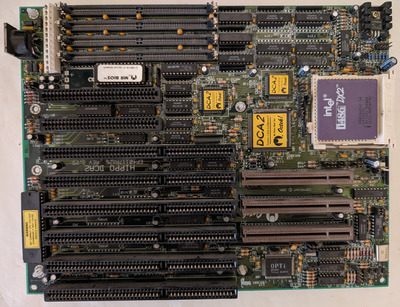First post, by appiah4
- Rank
- l33t++
I have this motherboard:
It's not a phenomenal motherboard by any means, but I want to test out 1. MR BIOS, 2. DCA capabilities (as I appear to have the necessary sticks of RAM for this).
Unfortunately, it is not working.
It came to my posession with two issues.
1. The onboard NiCd barrel battery had badly leaked. I unsoldered that and then cleaned it up with vinegar and IPA. It now looks pretty clean.
2. It had some bent legs on the chipset that were making contact. I carefully straightened these out (experience with Voodoo 2 cards helped here)
Unfortunately it would not POST. A POST card did not help either, as it would produce no numbers or beeps. I started poking around and after a while realized that the KBC was getting UNGODLY HOT when turned on. I immediately removed it (socketed KBC). I replaced it with a spare 83C42 I had lying about, and now I had life in the board. This time, the POST card completed up to 09 then got stuck at 0A and I got a beep Code: Low High Low Low Low Low
At this point I am not sure how to proceed. I have checked various sites and the 0A code appears to be:
- Initializing Base 64K RAM
- Base 64K memory test - Check beep code
And the LH-LLLL Beep code seems to imply: Base 64K Pattern Test Failure
I don't know where to look now, really. Off the top of my mind:
a) The battery damage was pretty close to the memory banks, so maybe the issue is the sockets or under the sockets? I do not look forward to desoldering all 8 banks. Soaking the whole area in vinegar then IPA may help, maybe? Any particular traces that I should check with regards to this error?
b) Could it be related to the chipset (ie damaged legs etc.) I don't know anything about the chipset on this motherboard (Headland HT340) whatsoever, so I don't even know which pins I should start checking.
c) Could it be that the KBC I installed is not 100% compatible? I can not immediately recall what the exact make/model of the faulty KBC was but I remember it was 82C42 compatible, not specifically 83C42..
d) Could it be the BIOS? I have some BIOS images on hand I could write onto the BIOS chip and try - worth a shot?
All pointers and help would be appreciated.
Retronautics: A digital gallery of my retro computers, hardware and projects.



